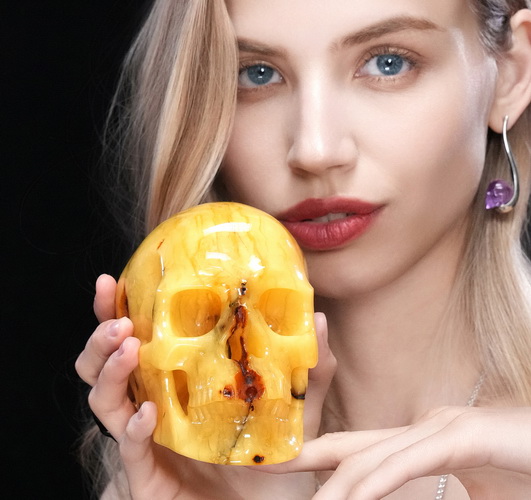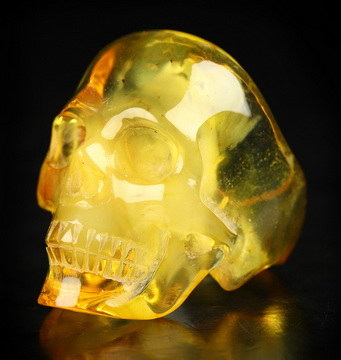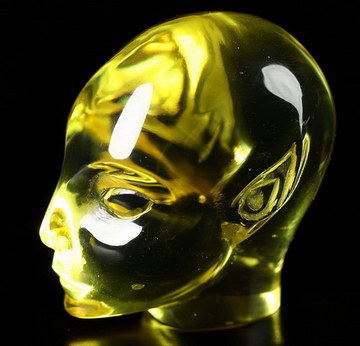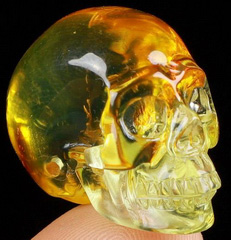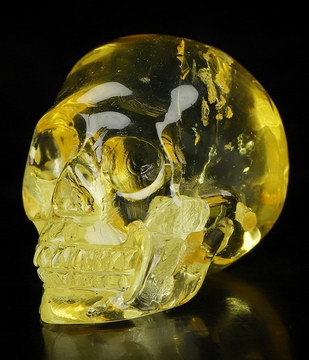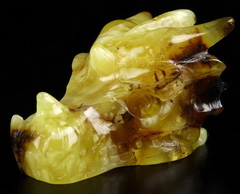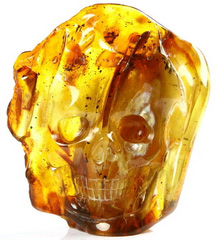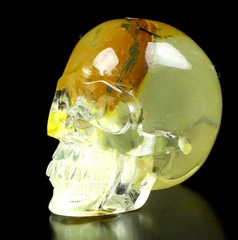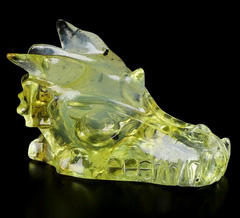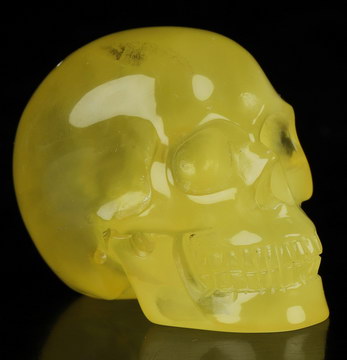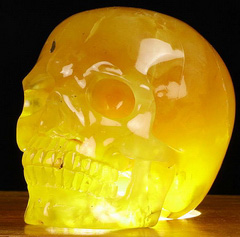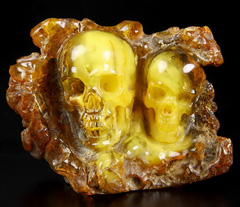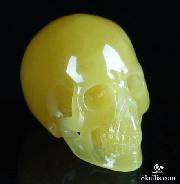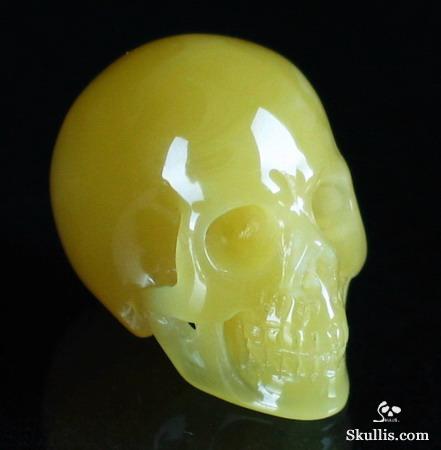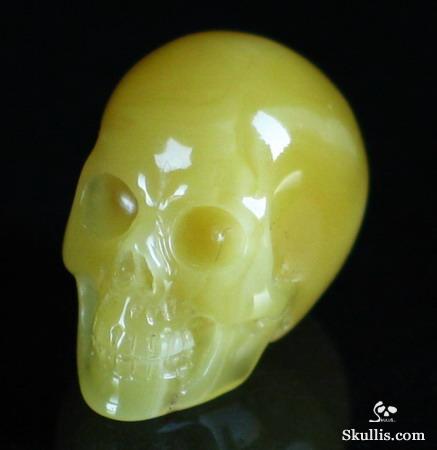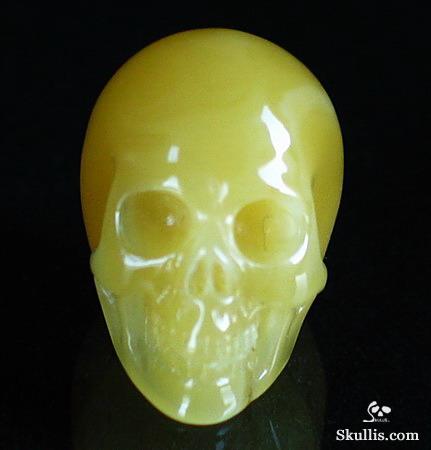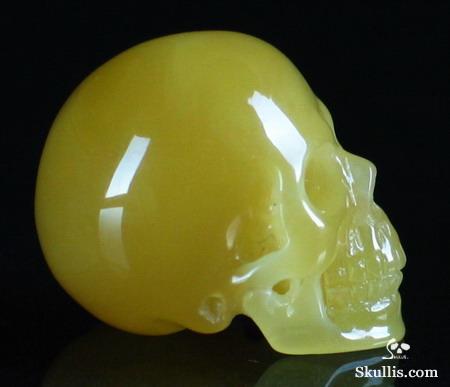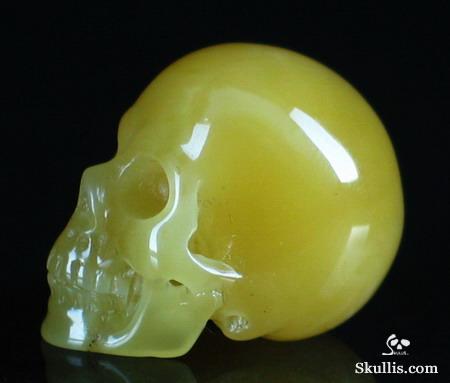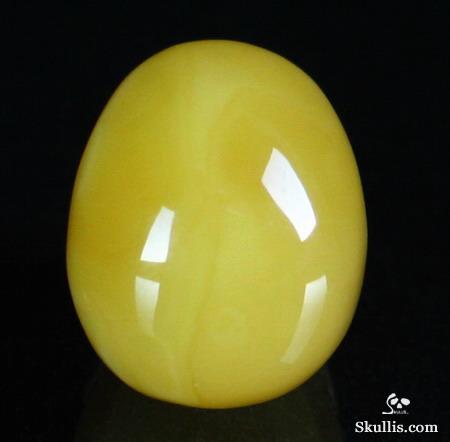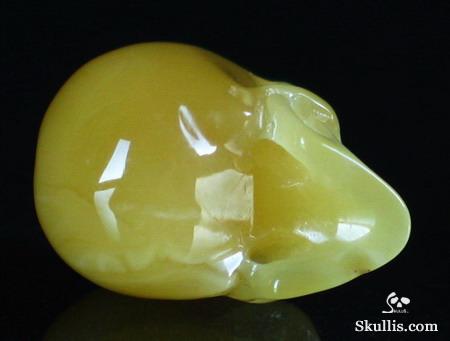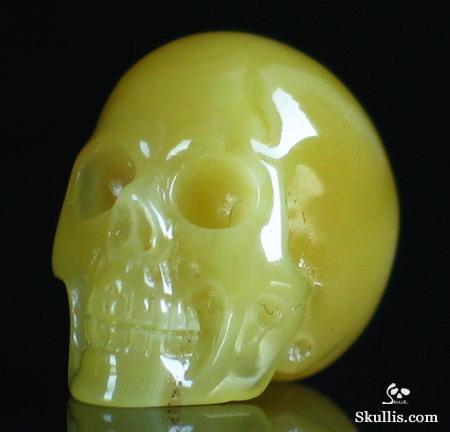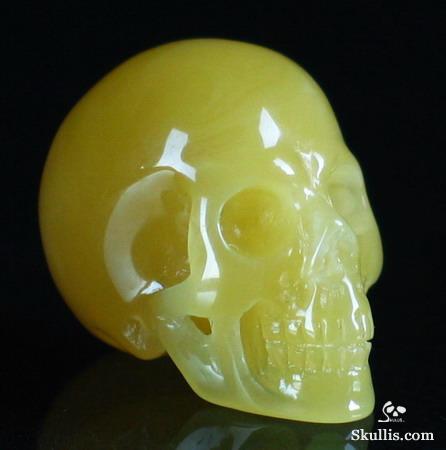You are looking at an Amber skull.
Amber is a most interesting substance. It is the fossilized resin of ancient trees. The aromatic resin oozed from trees and trapped debris such as insects, seeds, leaves, and bird feathers. Most of the world's true amber ranges between 30 to 90 million years. |
Color 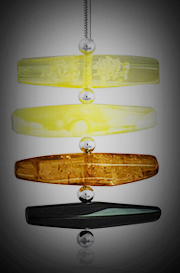
Amber occurs in a range of different colors. As well as the usual yellow-orange-brown that is associated with the color "amber", amber itself can range from a whitish color through a pale lemon yellow, to brown and almost black. Other more uncommon colors include red amber (sometimes known as "cherry amber"), green amber, and even blue amber, which is rare and highly sought after.
Transparency
A lot of the most highly-prized amber is transparent, in contrast to the very common cloudy amber and opaque amber. Opaque amber contains numerous minute bubbles. This kind of amber is known as "bony amber", even though it is in fact true amber. |
Some facts about amber you may want to know
Amber has been known since the ancient Greeks and was written about by Homer in the Odyssey. Aristotle and Plato also mentioned amber and Pliny the Elder explained its origins.
As a medicine, powdered amber was mixed with honey and used as a curative for asthma, gout, and the black plague. Today amber is still used as a medicine in some countries.
Amber was worn as amulets to preserve chastity and used as talismans to guard against evil. Sailors believed that burning amber would keep them safe from sea monsters. |
The two main sources of amber on the market today are the Baltic states and the Dominican Republic. Amber from the Baltic is older and more valuable but amber from the Dominican Republic is more likely to have insect inclusions, which are prized by collectors.
|
| Baltic amber |
|
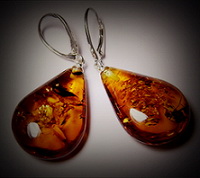 |
Of all the amber deposits in the world, probably the most famous and certainly the largest is that of the Baltic region. Amber from this source can be found on the East Coast of Britain all the way to the far shores of Estonia. It represents some 80% of the worlds known amber resource. Going back into prehistory this amber has been used and fashioned by humankind in countless ways. It dates from between 35 to 40 million years ago.
Most Baltic ambers are yellow or light yellow, and usually transparent. |
|
Dominican amber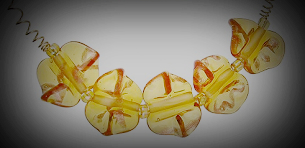
Dominican amber differentiates itself from Baltic amber by being nearly always transparent, and it has a higher number of fossil inclusions. This has enabled the detailed reconstruction of the ecosystem of a long-vanished tropical forest.
Dominican amber can be found in many colors, besides the obvious amber. Yellow and honey colored are fairly common. There is also red and green in smaller quantities and the rare blue amber.
|
Blue amber 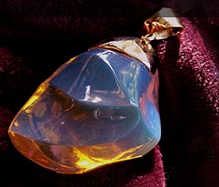
Blue amber is amber exhibiting a rare coloration. It is most commonly found in the amber mines in the mountain ranges around Santiago, Dominican republic.
Under artificial light, the amber appears like ordinary amber, but under sunlight it has an intense fluorescent blue glow.
When natural light strikes Blue Amber on a white surface, the light particles pass right through, and then are refracted off the white surface. Result: the Blue Amber has a slight blue hue. Hydrocarbons in the Blue Amber turn the sun's ultraviolet light into blue light particles, resulting in the glow of Blue Amber. |
Insect amber 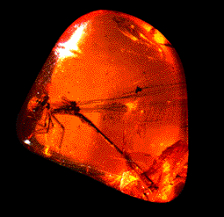
During the process of fossilization, a variety of flora and fauna tend to remain trapped in the amber resin and eventually become an integral part of the final gem--amber. Over the centuries fauna like larvae, caterpillars, bees, flies, butter flies, spiders and even land snails have been discovered in amber. The more unique the fossils in amber, the higher its value. So your amber can be the only piece in the world.
Jurassic Park made amber famous. The movie used the idea that amber containing an ancient mosquito might be the key to recreating dinosaurs. The basic goal was to remove blood from the gut of a mosquito that had fed on a dinosaur just before being trapped in tree resin which later became amber.
How to identify the true insect amber from its imitation? When insects got caught up in the Amber, their legs, antenna, and wings are caught in distressing character. The fake Amber insects look as if they were paid big bucks for their frozen pose in time, every part of there body is displayed perfectly. The same principle should be taken into consideration with flowers and scorpions.
|
Pricing and grading of an amber
The price of amber gemstone, to a large extent, depends on the life form that is preserving in it. Amber pieces with intact insects, plants flowers etc are considered very valuable and are highly priced. An amber necklace with insect trapped inside it, such as a dragonfly amber stone, will have high demand in the market.
Also the period from which amber comes can makes a significant difference in its price. The older the stone, the higher is its price. Pieces with unusual flora and fauna are a collector’s item. Fossils in amber always increase its value and beauty.
|
Identification of Amber from its imitations
There are frequent attempts made in the market to sell amber simulants as natural amber gemstone. Simulants of amber include ambroid, copal resin, kauri gum, dammar, celluloid and plastic.
The following are 10 simple ways to identify a true amber from its imitations.
1. Hardness
Amber has hardness on Moth’s scale in the region of 2 - 3. Using appropriate scratch sticks it should be reasonably straightforward to test the sample under question.
2. Hot needle
Heat a needlepoint in a flame until glowing red and then push the point into the sample for testing. With copal the needle melts the material quicker than amber and omits a light fragrant odor. Amber when tested does not melt as quickly as the copal and omits sooty fumes.
3. Solubility
Copal will dissolve in acetone. This test can be done by dispensing the acetone from an eyedropper onto a clean surface of the test specimen. Place one drop on the surface of the test piece and allow to evaporate, then place a second drop on the same area. Copal will become tacky; amber will remain unaffected by contact with acetone.
4. UV
Copal under a short-wave UV light shows hardly any color change. Amber fluoresces a pale shade of blue.
5. Friction
Rub the specimen vigorously on a soft cloth. True amber may omit a faint resinous fragrance but copal may actual begin to soften and the surface become sticky. Amber will also become heavily charged with static electricity and will easily pick up small pieces of loose paper.
6. Taste
taste the amber specimen after washing it in mild soapy water and then plain water. Though you could make no distinction between copal and amber, you could easily identify plastics and other common substitutes because of their unpleasant or chemical taste. Amber has hardly any taste at all.
7. Flotation
Mix 23 gums of standard table salt with 200 ml of luke warm water. Stir until completely dissolved. Amber should float in such a mixture and some copal's together with various plastics sink.
8. Inclusions
Infrequently amber contains Flora or Fauna inclusions. Correctly identifying the trapped Insect or plant should be an excellent indicator of a piece’s authenticity. Most inclusions from ancient amber are of species that are now extinct or significantly changed. Frequently present in Baltic amber are tiny Stella hairs which are release by oak buds during their early growth and some time after.
9. Knife cut
With a sharp knife try to shave off a tiny piece of the amber from an unobtrusive section. Real amber fractures and splinters. plastic and polymers actual cut and tiny shaved pieces can be removed without any splintering of the material.
10. Polarized light
Place the suspect piece of amber between two sheets of polarizing glass or plastic. Rotate one of the polarizing lenses slowly through 360 degrees. In the body of the amber a display of rainbow colors should cycle through the transparent parts of the material. Genuine amber and copal always show these color changes, where as some acrylics, polymers and certain plastic do not. Amber which has been drilled and then later filled with a contemporary inclusion and resin also reveals its self via the clear disruption of the color display. Essentially; an amber piece which does not show interference patterns is unlikely to be true amber. |
Taking Care of Amber Gemstone
Great care must be exercised while cleaning amber jewelry. It is essential that you do not wash the stone with hot or boiling water or keep it in a place where it can be exposed to high temperatures. Amber jewelry care also includes making sure that the stone is not exposed to acids or chemicals because this will cause the stone to deteriorate.
|
Till now, you must have gotten the general knowledge about amber. Can't wait to have an amber gemstone of your own? Please don't leave, and you may find the amber of your own right here in Skullis. Skullis guarantees the 100% anthenticity of the amber we offered. We will refund 10 times of what you have paid if you have ever bought any false amber from us. Enjoy !
|
 Baltic AmberBaltic Amber
Baltic AmberBaltic Amber
